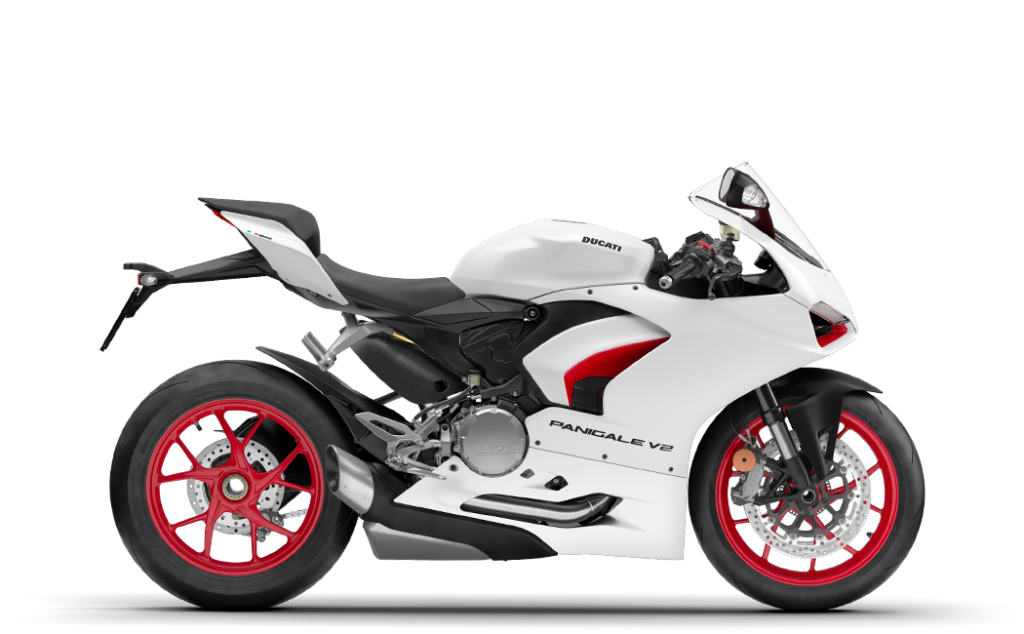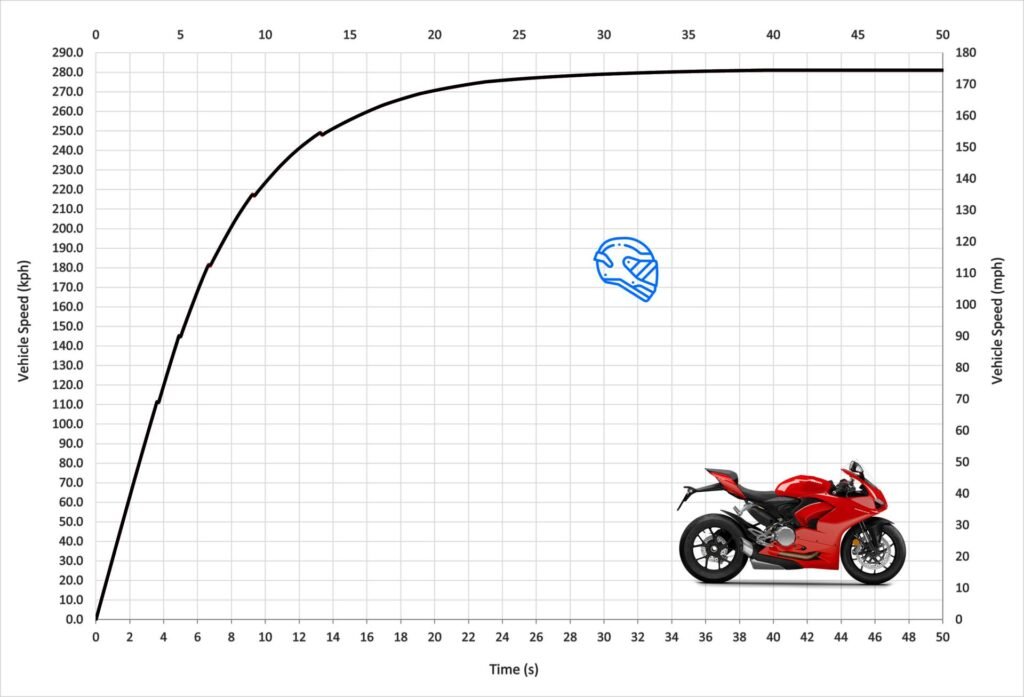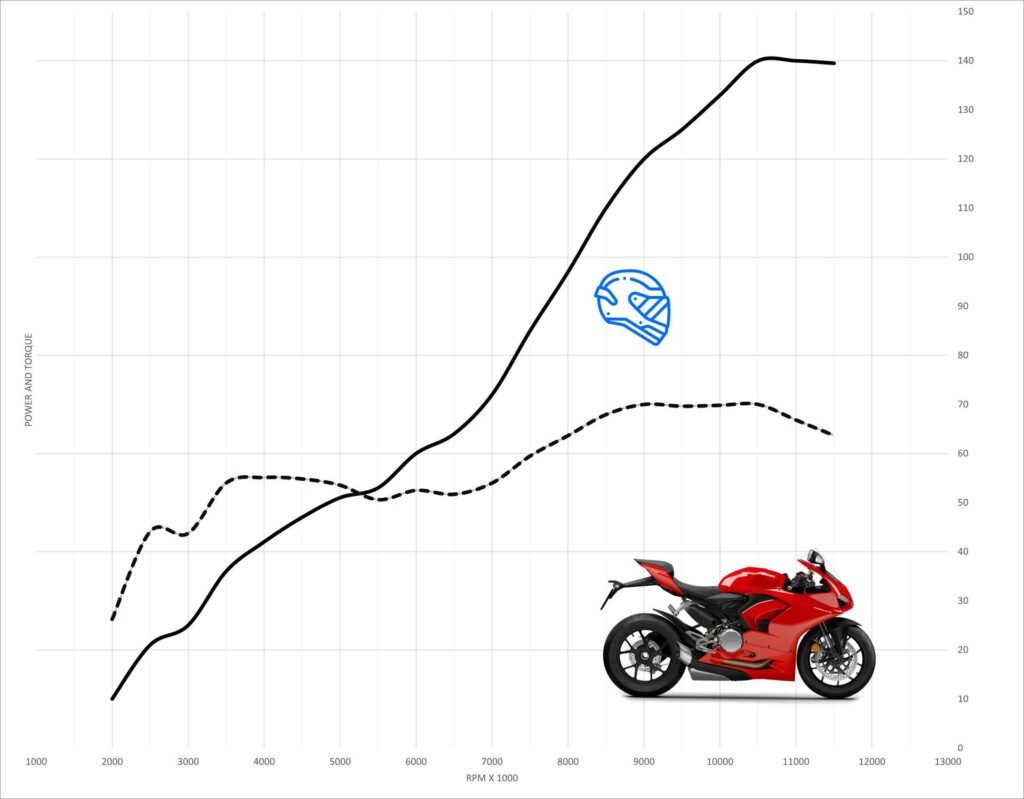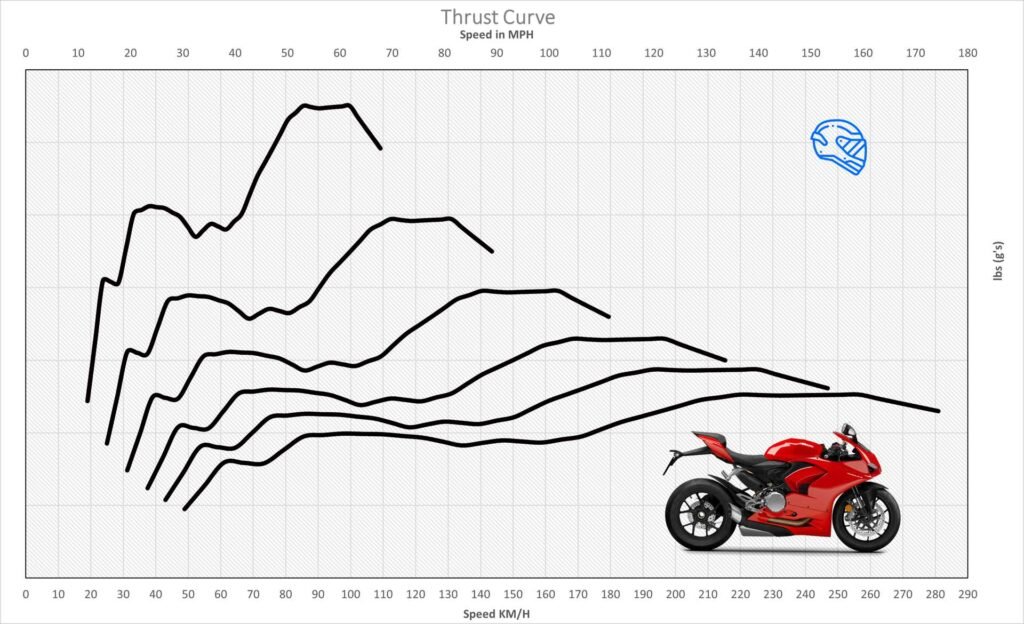Ducati Panigale V2 0-60 mph 3.09 seconds
Ducati’s latest Panigale V2 is the most recent of an exceptionally long line of beautiful two-cylinder Ducati’s.
Though in 2018 it looked like Ducati had turned their back on the L2 configuration that has served the Bologna brand so well.
The L2 configuration for so long garnered muh success on both the road and track.
Subsequent WSBK rule changes and ever newer faster and better competitors in the Superbike space had forced Ducati to move away from their tried and tested L2 platform.
Gone was the L2 to a configuration that embraces an extra 2 cylinders in the form of an all-new V4.
Post 2018 and despite Ducati having moved their competitive Superbike effort to the V4 platform the L2 still lives on today.
If the Ducati 851 eventually evolved into the V4 of today, we could possibly argue that the current V2 evolved from Ducati’s 748 Supersport offering.
That motorcycle that was the little sister to the 916/996 series.
We then got the 749 which was the little sister to the 999 while the 848 that replaced the 749 mirrored the 1098/1198 that replaced the 999 series.
While more recently the 899 and 959 were little siblings of the 1199 and 1299 Panigale respectively.
Ducati has been consistent with the family relations as we now have the V2 and the V4 .
The new Panigale V4 obviously took a more drastic evolutionary twist as it arguably has completely branched off from the 1299 it replaces.
While the Ducati Panigale V2 is not much different from the Panigale 959 it supersedes.
The Lineage of the V2 is evident as coming from the 748 though funny enough the current V2 has a bigger engine than the 851 and 916.
Today we have a 955 cc L2 motorcycle making a claimed 155 horsepower but is the softer option to the 200 horsepower plus V4.
We live in weird times when the entry-level Supersport/Superbike of a brand produces a claimed 155 horsepower.
Not too long ago, 150 horsepower motorcycles were at the pinnacle but now we have adventure motorcycle producing more power.
The original Ducati 916 made a claimed 114 horsepower and weighed approximately 20 kilograms more than the Latest Ducati Panigale V2.
The other mainstream 1000 cc twins of the time prduced (at the most) 135 horsepower at the crank!
Those L-Twins from the late 90s and early thousands were quite a bit porkier than the Ducati Panigale V2.
The Ducati 748 all the way up to the 899 series have never been about big-power.
These machines have mostly always been compared to 600s Supersports motorcycles as well as the one remaining 750 – that is the legendary Suzuki GSX-R750.
Not to mention MV Agusta’s fantastic F3 800 that has been a rival for a number of years.
This ‘Supersport’ class used to be solidly defined by an almost hard 600 cc cap for four-cylinder motorcycle and 749 cc twin cylinder and 675 cc for three cylinder motorcycles.
But the class has become murky and less defined with the Kawasaki Ninja 636, F3 675/800 and the Ducati 748s evolution into the 848, 899 and 959.
This has really confused the class.
The Ducati Panigale V2, despite being 955 cc and making a claimed 155 horsepower is still compared to 600 cc motorcycles.
This is despite the Ducati Panigale V2 being every bit a superbike in the traditional sense with its litrebike power, suite of electronics, light weight and svelt chassis.
Of course, in a sea of 200 plus horsepower 1000s and 1100s, the Ducati Panigale V2 is kind of outgunned in pure numbers terms.
But how does it perform?
Ducati Panigale V2 Dyno Curve
The L2 engine has come a long way since the late 90s and early 2000s and reached its peak with Ducati’s very own 1299.
While Ducati has abandoned the L2 platform in their flagship motorcycle the configuration persists today in the Ducati Panigale V2.
Ducati claim 155 horsepower @ 10,750 rpm and 76.7 ft/lb @ 9000 rpm which are very impressive numbers in any context.
It wasn’t ong ago that fully specced/built BSB and WSB Ducati 916s were making around 155 horsepower at the rear wheels and 170-175 horsepower at the crank.
On the dyno we expect to see 10-12% lost through transmission losses as the power makes its way from the crank to the rear wheel.
Not surprisingly the Ducati Panigale V2 makes an expected 140 horsepower at the rear wheel produced at 10500 rpm.
Peak torque is made between 9000 and 10500 rpm which makes for quite a peaky engine.
The Ducati Panigale V2 engine is remarkably like the 1199.
It is just scaled down with the Ducati Panigale V2 sharing a similar bore and stroke of 100 x 60.8 mm vs the Ducati Panigale 1199s slightly more oversquare 112 mm × 60.8 mm.
To make power you need to be able to rev high, and L2s of a similar engine capacity to fours have a harder time spinning at comparable rpm.
This is due to having larger pistons comparatively.
Additionally, it is hard to fill the large cylinder of the L2 with the necessary oxygen for an efficient explosion during the cycle due to the piston speed and larger volume of cylinder necessary to fill in a tiny fraction of time.
Therefore, the power curves of many L2s passed and present tend to often flatten off a little at around 8000-9000 rpm before hitting their limiters.
This is due partly to their inefficiency to fill the cylinder with air/fuel in enough time.
We often think of L2s as ‘torquey’ and more useable compared to four-cylinder motorcycles and we expect them to exhibit this expected characteristic when we open the throttle.
The ‘superior’ torque of a twin is more fiction than fact with power and torque of all engine configurations being much more to do with other specific design choices.
Such as bore and stroke, how high the motorcycle revs, cam profiles, and so on etc.
To prove the point the Ducati Panigale 1199 was never considered a ‘torquey’ motorcycle.
THis is the case also for the Ducati Panigale 899, 959, and the V2 despite all these motorcycles being L2 twins.
All the mentioned motorcycles are actually quite peaky engines that thrive on revs and only really come on song from 7000 rpm onward where they kick hard almost like a two-stroke.

None of the above motorcycles lacks torque as they all produce the expected peak torque based upon their engine capacities.
But it’s how that torque is distributed that will determine the character, and if they are considered torquey in the traditional sense and understanding.
The simple answer as to why their torque is being distributed differently is simply a symptom of increasing their ability to rev with the goal of making as much peak power as possible.
To achieve this, the Ducati Panigale V2 as well as its predecessors all have short-stroke oversquare engines.
Typically, the shorter the stroke of the engine, it will have less leverage.
So at lower speeds (rpm) they have a diminished ability to produce as much torque compared to the same engine with a longer stroke.
But they also can produce more torque at higher rpm and thus make more peak power as a result.
Think of the stroke of the engine like a lever undoing a nut.
The longer the level the more leverage on the nut and thus more torque can be applied with the same force provided at the lever.
Same for a piston with a long connecting rod that travels a greater distance during its stroke.
There are very many other variables that make up an engine’s ability to produce torque at specific rpms with the leverage of the piston being just one component.
Typically, L2 superbikes have opted for having longer stroke engines, while four-cylinder superbikes tend to have shorter stroke engines.
There are of course exceptions and overlap.
Well, the Ducati Panigale V2 is a short-stroke L2 engine and is designed to make as much peak power as is reasonably.
That peak power has to be made within the context of it being a useable road-going Superbike that has to meet various noise and emissions regulations while also being reliable.
140 horsepower at the rear wheels is very impressive for a road-going 955 cc L2.
This figure is right on par with the class-leading superbikes of the late nineties and early thousands such as R1s, Blades and GSX-R1000.
These machines produced between 130 and 145 horsepower at the rear wheel.
At the top-end, the Ducati Panigale V2 offers similar performance to these litre fours but really does not do much comparatively until you drive it through 7000 rpm.
Which is where it picks up very quickly and drives with some decent veracity.
To be fair, between 3500 and a little under 5000 rpm there is decent torque and drive available but that hole in the midrange is hard to escape.
This is becuase you often find yourself in this flat spot on the road and under normal riding conditions.
So you often need to kick it down a gear or two if you really must leave as if your life depended on it.
In the first 3 gears, it is not too noticeable.
This is in part becuase often designers of L2 Superbikes opt for lower gear ratios comparable to competing fours, while the last four gears tend to be a little longer.
There are exceptions to this of course.
If you look at the thrust curve you can see how the torque curve plays out in each gear.
YYou can see decent peak of thrust/acceleration at the start of each gear and then that hole right in the middle of the speed range of each gear.
Then like a two-stroke you can see how quickly the Ducati Panigale V2 comes on cam and piles on massive thrust and acceleration in a noticeably short period of time.
If you enjoy high rpm two-strokes, or chasing revs for a great reward than the Ducati Panigale V2 engine is really for you.
If you want a grunty and lazy engine more in line with L2’s of the past than this engine is not for you.
Though of course, at the very least some of that hole in the midrange could be filled in with a good exhaust system and tune.
But you still can’t remedy the fact that this engine is of a short stroke design where its torque is specifically designed to be made at high rpm to achieve good peak power
Ducati Panigale V2 Thrust Curve
The Ducati Panigale V2 is no slouch but its performance is overshadowed by the fact that we live in a world of 200 plus horsepower motorcycles.
So having 50 horsepower less will always objectively mean that the L2 will be slower in a straight line all other things being equal.
It’s a shame because the Ducati Panigale V2 is amazingly fast and will be at the very least as quick as Yamaha R1’s from 98-03 or the Honda CBR954RR.
The Suzuki GSX-R1000 from 01-02 would likely have the edge on it but the Ducati Panigale V2 would be biting on its heels for sure.
Also, the Ducati Panigale V2 has enough ‘go’ and will also bite on the heels of the next-gen of thousands that came after 2003,.
Such as the K5 Suzuki GSX-R1000 but would very likely lose out above 140 mph.
In terms of numbers, the Ducati Panigale V2 really does deliver.
Surprisingly, unlike many Ducati’s the Panigale V2 is easy to launch and achieves good numbers.
I have never liked hydraulic clutches but the Ducati Panigale V2s lutch is light and has a decent feel. The quick shifter is fast and accurate.
With the gadgets turned off the Ducati Panigale V2 does like to wheelie.
Its engine character and how it delivers its power is remarkably like the latest generation Yamaha YZF-R1, albeit you must change up sooner.
This is becuase the Ducati Panigale V2 does not rev as high as the Yamaha YZF-R1.
All powerful motorcycles require a fair bit of skill to get them out of the hole and the Ducati Panigale V2 is no different.
But once you get familiar using the clutch and you maintain a steady throttle hand to control the wheelies great times can be had.
Ducati Panigale V2 was able to manage a 0-60 mph in only 3.09
The Ducati Panigale V2 was able to manage a 0-60 mph in only 3.09 seconds and a 0-100 km/h time of 3.21 seconds.
This makes the Panigale V2 one of the quicker motorcycles that we have tested for the 0-60 mph or 0-100 km/h sprint.
This is despite being down on power versus some of those it’s up against.
Feed the Ducati Panigale V2 gears via its slick and fast quickshifer and it will gladly eat them up in a frenzy of L2 drone as it rampantly accelerates.
0-100 mph for the Panigale V2 is fired off in an impressive time of 5.67 seconds!
But this feat does require a change to second gear costing it a fraction of a second compared to some Superbikes that can manage 100 mph in only first gear.
Regardless, this time is pretty much as fast as any other litrebike of today including the 200 horsepower monsters that overshadow the Ducati Panigale V2 on paper.

It is only after 100mph and just as the V2 gets into third while still hugely accelerative, its deficit in power compared to more powerful motorcycles takes hold.
Still, the Panigale V2 manages a 0-200 km/h time of 7.92 seconds achieving a little way through fourth gear.
The Ducati Panigale V2’s quarter mile of 10.44 at 142 mph time is a ballpark for most 1000 cc superbike in terms of ET. But is down by around 8-10 mph on the termina speedl crossing the line.
What this suggests is that the V2 gets out of the hole at least as fast as other faster literbikes but is chased down and either matched or passed at the line.
0-150 mph which is a great benchmark for Supersport and Superbikes take only 12 seconds flat and is only around 2 seconds slower than the fastest Superbikes.
The Ducati Panigale V2 thrives on revs with gears being quite spaced out with no overlap.
So other than hitting the limiter there is very little danger of revving it too much before changing gear and losing time.
For best ET’s it is pretty much safe to change up every gear just before the rev limiter or at around 11500 rpm for the very best results.
The Dragy 60-130 mph can be achieved in second or first gear.
In any real-world situation, you would be more likely and more consistent in second gear.
Doiing so will mean that wheelies are less likely and easier to control but the absolute best times can be achieved if in first gear.
You need to roll from around 40 mph while controlling the inevitable wheelies as you pass through 60 mph and up to close to 80 mph as you approach the redline.
Doing so in first gear does mean an extra gear change but overall, even if you lose a fraction of time from the gear change you gain.
This is due to there being more thrust available in first gear from 60 mph ithan the thrust available in second gear from the same speed.
The Ducati Panigale V2 very impressively achieved a 60-130 mph time in 5.55 seconds.
Inn the real world if you are a light and skilled rider realistically you would be doing low to mid 6 seconds times mostly.
Ducati Panigale V2 top speed is 174 mph
The Ducati Panigale V2 will show 299/186mph like almost all big superbikes of the last 20 years.
The best top speed we managed was 174 mph!!
The Ducati Panigale V2 will get to a real 160 mph effortlessly but will need quite a bit of room to stretch its legs beyond that needing around 1 mile from a standing start to get to its peak.
Unless you have an exceptionally long clear and straight road hitting the max top speed might be quite difficult.
Overall, the Ducati Panigale V2 is amazingly fast and accelerative but you must work the engine more than superbikes with similar power.
This is definately case comapring the Ducati Panigale V2 to older litrebikes from the very early thousands.
For example, at highway speeds, you would need fourth gear on the Ducati Panigale V2 to beat a 1998 Yamaha YZF-R1 in sixth from 70-90 mph.
Even in fifth the Ducati Panigale V2 would be beaten from that speed, but above 7000 rpm the V2 punches a fair bit harder in the lower three gears than the 1998 Yamaha YZF-R1.
The Ducati Panigale V2 even punches slightly more in fourth but offers a similar punch in fifth and sixth gears above 7000 rpm.
Ultimately though, litrebike thousands current and in the past are more flexible and have wider power/torque ranges so require less working of the gearbox than the Ducati Panigale V2.
I would argue though that the Ducati Panigale V2s engine and experience is a more exciting and engaging.
If we compare the Ducati Panigale V2 to its current peers which would be the F3 800, the GSX-R750, and the Triumph 765 Daytona.
The Ducati Panigale V2 pretty much dominates for outright acceleration.
iI is highly likely to be dominant in-gear too, but I would need to look closer at the thrust curves of rival bikes in the class.
Ducati Panigale V2 Acceleration Curve

| Ducati Panigale V2 | |
| Speed | Time |
| 0-10 mph | 0.45 |
| 0-20 mph | 1.00 |
| 0-30 mph | 1.52 |
| 0-40 mph | 2.04 |
| 0-50 mph | 2.49 |
| 0-60 mph | 3.09 |
| 0-70 mph | 3.77 |
| 0-80 mph | 4.31 |
| 0-90 mph | 5.00 |
| 0-100 mph | 5.67 |
| 0-110 mph | 6.40 |
| 0-120 mph | 7.47 |
| 0-130 mph | 8.55 |
| 0-140 mph | 10.13 |
| 0-150 mph | 12.00 |
| 0-160 mph | 15.20 |
| 0-170 mph | 21.02 |
| 60-130 mph | 5.45 |
| 100-150 mph | 6.28 |
| SS/QM | 10.44@142 mph |
| SS/KM | 18.96@167 mph |
| SS/Mile | 26.80@173 mph |
| Top Speed | 174 mph |




















